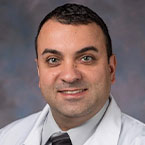By: Catherine A. Fabian, MD & Kris R. Jatana, MD, FAAP, FACS
A hit to the face during sports or other activities can leave a child with a sore—and sometimes broken—nose.
A broken nose or nasal injury can be scary for your child and you, especially if the nose is bleeding a lot or looks out of place. When this happens, it is important for your child to be seen by a medical professional. They can check for other injuries that may not be visible to you. This involves a thorough history and exam, focusing on the nasal trauma as well as possible injuries involving the eyes, head, facial bones or mouth.
Will my child need an x-ray for a broken nose?
Even if your child's nose is crooked, they may not need an x-ray or other imaging tests—as long as their nose is the only part of the face that hurts or is injured. Getting an x-ray for an isolated nose injury can be an unnecessary cost. It also exposes your child to radiation that might not change the treatment decisions made.
You and your doctor can discuss the pros and cons of the x-ray in your child's situation. This will help with the decision whether your child might benefit from an x-ray in your child's specific injury.
When an imaging test may be recommended for nasal injury
A computed tomography (CT) imaging scan may be considered for your child if their medical professional is concerned about the following:
Injury to other nearby structures—the eyes, mouth, other parts of the face or head
A concussion or brain injury
Bleeding from somewhere other than the nose
Other complications such as signs of infection (fever, nasal drainage, swelling or redness of the nose) that may start days later
How is a broken nose treated?
Consider
over-the-counter pain medications for your child's discomfort.
Surgery to reset a broken nose
If your child's nose is broken and off-center, or if your child is having trouble with breathing, a surgeon might need to adjust your child's nose back into place. This surgery usually needs to be done under anesthesia within one to two weeks of the injury, before the nose heals.If there are other suspected injuries or complications seen on exam or CT scan, other specialists may need to be involved for further evaluations and treatments.
About Dr. Fabian
 Catherine Fabian, MD is an anesthesiology resident at the University of Michigan Health System. She graduated from medical school at The Ohio State University College of Medicine in 2022 as a member of AOA and the Gold Humanism Honor Society. Catherine Fabian, MD is an anesthesiology resident at the University of Michigan Health System. She graduated from medical school at The Ohio State University College of Medicine in 2022 as a member of AOA and the Gold Humanism Honor Society.
|
About Dr. Jatana
 Kris Jatana, MD, FAAP, FACS is a Professor of Otolaryngology-Head and Neck Surgery at Nationwide Children’s Hospital and Ohio State University; he serves as Director of Clinical Outcomes for the Surgical Services and Pediatric Otolaryngology Quality Improvement. Specific clinical expertise includes pediatric benign and malignant tumors and complex congenital masses of the head and neck, thyroid disease, maxillofacial trauma and reconstruction, hearing loss, aerodigestive foreign bodies and injury prevention. Kris Jatana, MD, FAAP, FACS is a Professor of Otolaryngology-Head and Neck Surgery at Nationwide Children’s Hospital and Ohio State University; he serves as Director of Clinical Outcomes for the Surgical Services and Pediatric Otolaryngology Quality Improvement. Specific clinical expertise includes pediatric benign and malignant tumors and complex congenital masses of the head and neck, thyroid disease, maxillofacial trauma and reconstruction, hearing loss, aerodigestive foreign bodies and injury prevention.
|